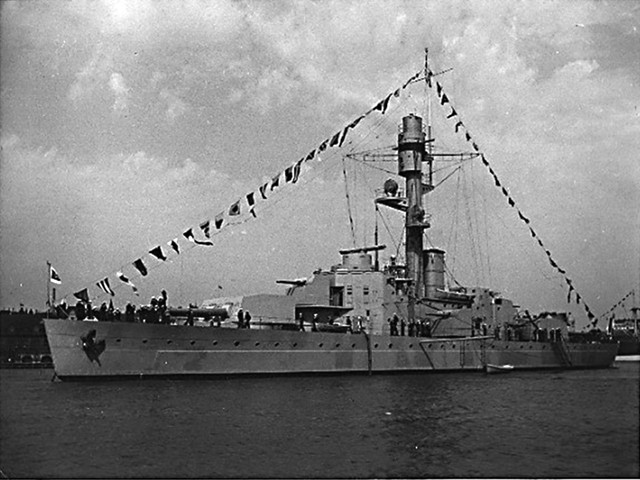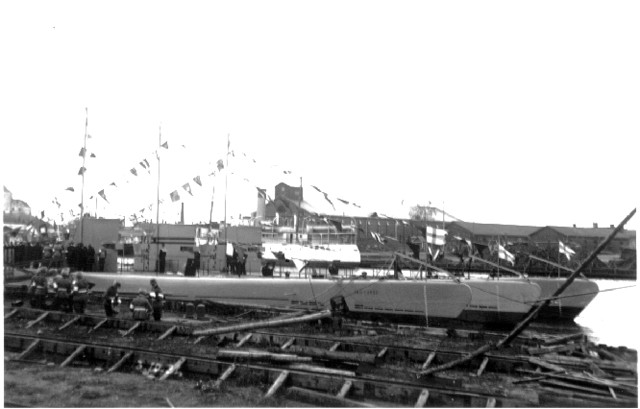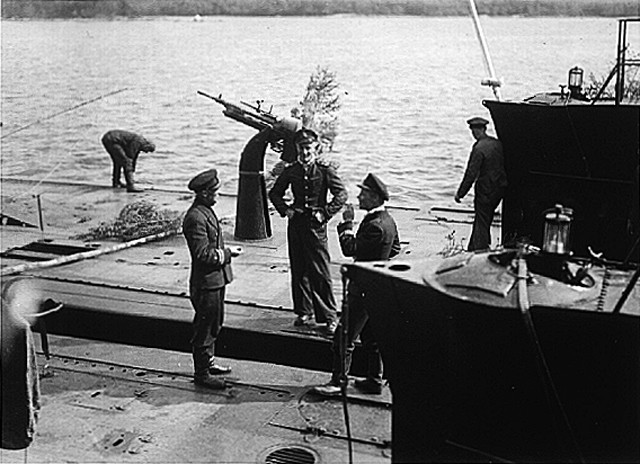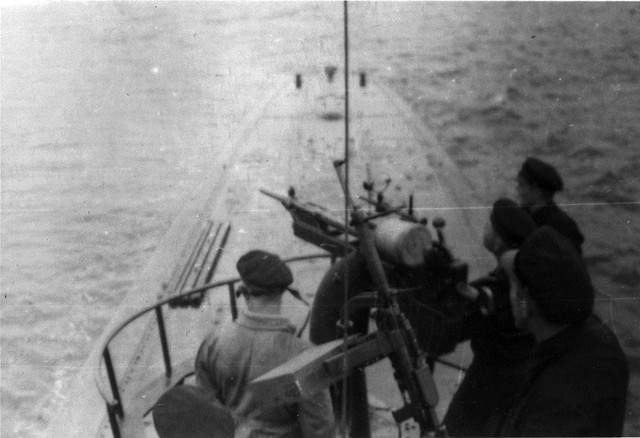In Winter War the ships had grey color and when stationed in Turku they had white camouflage.
During the interim peace color was dark gray and in Continuation War a splinter camouflage scheme was used.

Modifications in armament:
There were three different submarine types in the Finnish navy. To distinguish between these types following points are useful:
| Before the Winter War the "Vetehinen" class submarines were painted light grey and they had rings around conning tower. Vetehinen had one, Vesihiisi two and Iku-Turso none. |  |
During the peace time between Winter War and Continuation War the "Vetehinen" class submarines were painted dark and they had large numbers painted on the tower: 1 - Vetehinen, 2 - Vesihiisi and 3 - Iku-Turso.
| During the winter 1941-42 the 20-mm Madsen gun of the "Vetehinen" class boats was moved from after deck to tower. |  |
 |
The ships that were classified as gunboats were following:
Klas Horn and Matti Kurki had the typical old torpedo boat destroyer profile with round foredeck and a gun in front of the bridge. These ships were decommissioned in 1930's. Usually it is said that Matti Kurki was sunk as gunnery target and Klas Horn became accommodation ship. However, there is a photo taken after Continuation War where Matti Kurki is reduced to a barge. There are some points to tell apart Matti Kurki and Klas Horn:
In Winter War and Continuation War the real gunboats were the two pairs Turunmaa - Karjala and Uusimaa - Hämeenmaa. There are some points that can be used to tell apart the boat types:
Before the Winter War Turunmaa had a dark ring around the smoke stack while Karjala had none.
Changes in armament:
Uusimaa and Hämeenmaa
The old torpedoboats seized in 1918 were "Sokol" class or "Tsiklon" class [Mer68b]. In Breyer [Bre92] there are four classes that are "Sokol" or direct successors for it. The original Sokol was constructed by Yarrow & Co, Poplar in 1895 and later renamed Prytkij. It was the only ship of its type and followed by 13 ships of "Rezvyj" class, four ships of "Pylkij" class, and 22 ships of slightly larger "Boykyj" class. "Tsiklon" class boats were built under French licence [Bre92]. They were named Minonosets 214 to 223.
| Name in Finland | Original | Original | Commissioned | Builder | Fate |
| S 1 | Rjanyj | Sova | 1901 | Nevskij, St. Petersburg | Sunk as gunnery target in 1930's |
| S 2 | Prozorlivyj | Gagara | 1901 | Nevskij, St. Petersburg | Capsized and sank in storm 4.10.1925. Raised 1926 and scrapped. |
| S 3 | Poslushnyj | Korshun | 1900 | Crichton, Turku | Returned to Soviet Union 1922. Scrapped 1925. |
| S 4 | Rezvyj | Voron | 1900 | Nevskij, St. Petersburg | Returned to Soviet Union 1922. Scrapped 1925. |
| S 5 | Podvizhnyj | Albatros | 1900 | Izhora, St. Petersburg | Sunk as decoy 1944. |
| S 6 | Minonosets 212 | 1902 | Crichton, Turku | Returned to Soviet Union 1922. | |
| C 1 | Minonosets 215 | 1902 | Nevskij, St. Petersburg | Crushed in ice and sunk 1919. | |
| C 2 | Minonosets 216 | 1902 | Nevskij, St. Petersburg | Crushed in ice and sunk 1919. | |
| C 3 | Minonosets 217 | 1902 | Nevskij, St. Petersburg | Crushed in ice and sunk 1919. | |
| C 4 | Minonosets 219 | 1902 | Nevskij, St. Petersburg | Broken up in Finland |
The "Sokol" class ships had four smokestacks and "Tsiklon" class ships three.
The torpedoboat S 1 had mast in front of the bridge and S 2 and S 5 behind.
During the wars Finland had eight different motor torpedo boat types:
In 1941 some Thornycroft boats had pictures painted on the sides of cockpit. They had connection to boat names. Nuoli had an arrow, Syöksy a stylished letter "S".
In 1942 the four Thornycroft boats had pictures of Aces painted on the sides of cockpit. Ace of Hearts = Nuoli, Ace of Clubs = Vinha, Ace of Diamonds = Syöksy, Ace of Spades = Raju.
In 1943 and 1944 the boats had a three-digit number. First number = Flotilla, second number = group, third number = boat.
Motor launches of the Coast Guard were used as Patrol Boats (Vartiomoottorivene, VMV). They were built in two batches. The first ones were built in 1930-1932 and numbered VMV 1 to VMV 7. The second batch was built 1935 and numbered VMV 8 to VMV 17. Of these boats VMV 3 and VMV 7 were lost before the wars. VMV 1 to VMV 7 had gasoline engines and the newer ones gas oil engines. There is a clear difference in the superstructure of old and new boats. In older boats there is a clear space between air intake and deckhouse and in the newer boats the deckhouse was moved forward.
The boats VMV 5 and VMV 6 had higher deckhouse than other ones.
The camouflage pattern in the beginning of Continuation War was varying versions of short light wavy lines. In 1943 and 1944 the common pattern in VMV boats were broad, reddish brown horizontal lines along the whole boat length [Hau07]. Boats used in securing of coast defence ship Väinämöinen and minelayers had often no camouflage pattern at all. They were painted light grey and the boat number was painted in large number on deckhouse sides. In 1942 and 1943 the front deck was painted yellow for identificaton.
The small mine sweeper boats consisted of three classes:
All these boats look quite identical. "Ahven" class boats were developed from old A-boats and "Kuha" class boats were modified from "Ahven" class.
"Kuha" class boats were slightly larger than "Ahven" class, about 10 cm larger beam and longer foredeck. Probably the easiest way to tell apart "Ahven" and "Kuha" is to look to the portholes. "Ahven" class boats had four evenly spaced portholes and "Kuha" class boats six, in order 1 + 1 + 4 counting from the bow.
The 1941 batch of "Kuha" class has rounded deckhouse front wall and in the boats built after the war the deckhouse has straight walls.